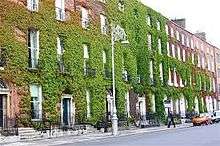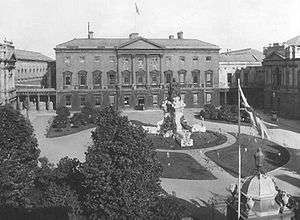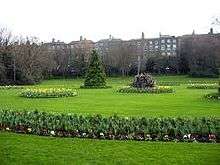Merrion Square

Merrion Square (Irish: Cearnóg Mhuirfean) is a Georgian garden square on the southside of Dublin city centre.
History
The square was laid out after 1762 and was largely complete by the beginning of the 19th century. The demand for such Georgian townhouse residences south of the River Liffey had been fueled by the decision of the then Earl of Kildare (later the Duke of Leinster) to build his Dublin home on the then undeveloped southside. He constructed the largest aristocratic residence in Dublin, Leinster House, second only to Dublin Castle. As a result of this construction, three new residential squares appeared on the Southside, Merrion Square (facing the garden front of Leinster House), St Stephen's Green and the smallest and last of Dublin's five Georgian squares to be built, Fitzwilliam Square.
Aristocrats, bishops and the wealthy sold their northside townhouses and migrated to the new southside developments.

The statue of Queen Victoria in the courtyard was removed in 1947. This view shows the original ducal palace at the heart of a spreading complex of buildings.
Legacy
Merrion Square is considered one of the city's finest surviving squares. Three sides are lined with Georgian redbrick townhouses; the West side abuts the grounds of Leinster House (seat of the Oireachtas), Government Buildings, the Natural History Museum and the National Gallery. The central railed-off garden is now a public park.
The Wellington Testimonial to commemorate the victories of Arthur Wellesley, 1st Duke of Wellington, was originally planned to be located in Merrion Square. However it was built in the Phoenix Park after opposition from the square's residents.[1]
Occupancy

Until about the 1950s, the houses in the square were largely residential, but today most of them are used for office accommodation. The Irish Red Cross and the Irish Georgian Society have their headquarters on the square.
The poet, novelist, and satirist Oscar Wilde lived at No. 1, poet W. B. Yeats lived at No. 82, and Daniel O'Connell at No. 58, now home to the Keough-Naughton Center of the University of Notre Dame. The National Maternity Hospital is on the North terrace. A number of houses in the square have plaques with historical information on former notable residents, including A.E. (George William Russell) and Sheridan Le Fanu.
Until 1972 the British Embassy was based at No 39; however, following the Bloody Sunday shootings in Northern Ireland, a crowd of over 20,000 people converged on the site in protest and the building was burnt to the ground.[2]
Currently, the Embassies of France and Slovakia are based on the south side of the square.[3]
Park

The earliest plan of the park shows a double line of trees around the perimeter which was later enclosed by railings in the early years of the 19th century. A 'Jardin Anglaise' approach was adopted for the layout of the park with contoured grass areas, informal tree clumps, sunken curved paths and perimeter planting.[4]
Up until the 1960s the park was only open to residents in possession of a private key. Now managed by Dublin City Council, the park contains a statue of Oscar Wilde, who resided in No. 1, Merrion Square from 1855 to 1876, many other sculptures and a collection of old Dublin lamp standards. The Irish American sculptor Jerome Connor, best known for his work Nuns of the Battlefield in Washington DC, designed the public art piece, "Eire".[5] The park also contains a sculpture of a Jester's Chair in memory of Father Ted star Dermot Morgan.
The park in the square was called "Archbishop Ryan Park", after Dermot Ryan, the Catholic archbishop who transferred ownership to the city. In 2009, Dermot Ryan was criticised in the Murphy Report; in January 2010, Dublin City Council sought public views on renaming the Park.[6] In September 2010, the City Council voted to rename the park as Merrion Square Park.[7]
Notable residents
Merrion Square was a fashionable address for politicians, lawyers, doctors and writers. Notable residents include;
- The Rev'd Gilbert Austin - Educator, clergyman and author[8]
- The Very Reverend Henry Montague Browne - Dean of Lismore of The Church Of Ireland
- Sir Dominic Corrigan - Physician
- Sir Philip Crampton - Surgeon[9]
- Richard FitzWilliam, 7th Viscount FitzWilliam - Irish peer and musical antiquarian
- John Leslie Foster - Barrister, judge and MP
- Edward Gibson, 1st Baron Ashbourne - Lawyer and Lord Chancellor of Ireland
- Henry Grattan - Politician and MP
- Robert James Graves - Surgeon
- Charles Hemphill, 1st Baron Hemphill - Politician and barrister
- George Knox - Politician and MP
- Valentine Lawless, 2nd Baron Cloncurry - Politician and landowner
- Sheridan Le Fanu - Writer
- Robert Spencer Dyer Lyons - Physician and MP
- Sir Henry Marsh - Surgeon
- John Henry North - Barrister, judge and MP
- Daniel O'Connell - Politician and MP
- Edward Pennefather - Judge
- Richard Pennefather - Judge
- David Richard Pigot - Judge
- Sir Andrew Porter - Judge
- George William Russell - Poet and painter
- John Stratford, 1st Earl of Aldborough - Irish Peer and MP
- Whitley Stokes - Lawyer and Celtic scholar
- William Stokes, Snr - Physician
- William Stokes, Jnr - Surgeon
- John Lighton Synge - Physicist
- Oscar Wilde - Writer and poet
- Sir William Wilde - Writer and surgeon
- W. B. Yeats - Poet, playwright and Senator
- Richard Bolton McCausland - Surgeon
See also
References
- ↑ Garnett, P. F. (June–August 1952). "The Wellington Testimonial". Dublin Historical Record. 13 (2): 48–61. doi:10.2307/30105448.
- ↑ "1972: British embassy in Dublin destroyed". BBC News. 2 February 1972.
- ↑ New French Embassy Opens in Merrion Square - The Irish Times, 24-04-2015
- ↑ http://www.dublincity.ie/main-menu-services-recreation-culture-dublin-city-parks-visit-park/merrion-square-park
- ↑ ITMA
- ↑ McGarry, Patsy (12 January 2010). "Councillor denies call to rename Archbishop Ryan Park". The Irish Times. Retrieved 12 January 2010.
- ↑ "City park to be renamed Merrion Square Park". The Irish Times. 9 September 2010.
- ↑ At 12 Merrion Square, North: The Treble Almanack ... (1832), p. 17.
- ↑ Dublin Hospital Gazette , 15 June 1858, p 192, https://books.google.co.uk/books?id=NG0BAAAAYAAJ&pg=PA192&dq=Sir+Philip+Crampton&hl=en&sa=X&ei=P5wOVZO7Goaa7gaEi4DYCw&ved=0CDYQ6AEwBA#v=onepage&q=Sir%20Philip%20Crampton&f=false
External links
![]() Media related to Merrion Square at Wikimedia Commons
Media related to Merrion Square at Wikimedia Commons
- Archiseek.com Doorways Archiseek.com Doorways
Coordinates: 53°20′23″N 6°14′57″W / 53.33972°N 6.24917°W